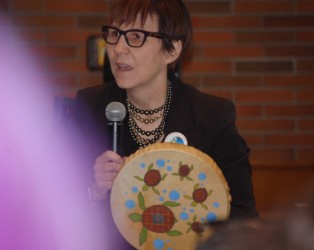Article Origin
Volume
Issue
Year
Advancing reconciliation in the sphere of post-secondary education will take more than a faculty of Native studies, a tipi on university property, and an Aboriginal students’ centre.
It will also take more than a poster recruiting Aboriginal students, says Cindy Blackstock, an associate professor at the University of Alberta. She says it starts in the classroom on reserves, where First Nations children receive one-third less funding for education than their off-reserve counterparts. Universities need to take a stand against this.
“Take down those (Aboriginal recruitment) posters and get out the prime minister’s address and don’t leave there until he or she does it right. That will make this a welcoming place for First Nations students,” Blackstock
said to a packed lecture theatre full of Aboriginal and non-Aboriginal students and faculty at the U of A, other post-secondary institutions, and the general public.
Blackstock, who is also executive director of First Nations Child and Family Caring Society of Canada, is leading, along with the Assembly of First Nations, a human rights challenge against the federal government claiming that children on reserve are discriminated against because they are funded at a lower rate than what similar provincial programs receive from the provinces.
Blackstock’s address was part of the comments made by three academics who discussed implementing the Truth and Reconciliation Commission’s calls to action at and by post-secondary institutions.
Dr. Eber Hampton, an academic Elder and special advisor to continuing education at the U of A, says that “conservatively” 37 of the 94 calls to actions outlined by the TRC in June pertain to post-secondary institutions.
“There’s no excuse for not putting some weight behind those calls for action. We’ve got our blueprint,” said Hampton, who is also past president of the First Nations University of Canada. “Universities either reproduce the status quo or they transform it.”
Those calls to action are wide-ranging and deal with research, teaching, service and certification and, Hampton says, they need to be implemented across every faculty.
Charlene Bearhead, newly appointed education coordinator for the National Centre for Truth and Reconciliation, agrees with Hampton’s assessment that Aboriginal knowledge and issues must transcend faculty lines. She says there is no reconciliation without relationship.
“Those calls to action focus on health, they focus on the law, they focus on justice, on social work, on education, on business. This is not a subject we study. This is who we are. Indigenous and non-Indigenous Canadians living and working together in a respectful manner. That doesn’t have a department or faculty,” she said.
Bearhead, who
received her degree at the U of A, says she
was never educated about residential schools. She adds that at the time she pursued post-secondary education nobody learned about residential schools.
But things are changing. Bearhead says student teachers are in the classroom, teaching students and the classroom teacher about the impacts of residential schools.
Bearhead has been traveling the country, talking to post-secondary institutions, most recently along the east coast, hosting similar sessions as the one at the U of A.
“Universities across the country are really taking a look at what this looks like and what needs to happen,” she said. “They’re looking across the faculties and within the grounds and within the architecture and within the ways of being and operating and knowing one another. It’s a good start.”
Every region will implement the calls to action differently, she says.
“Primarily, first and foremost, the universities across the country are located in different traditional territories. From my perspective if people are doing things well and doing things right, which is doing things respectfully based on protocol, those discussions and those actions will reflect the traditional people whose territories those universities are on,” she said.
Bearhead says there is much work ahead.
“For the most part, universities are colonial institutions Ö so I think there are big changes to be done no matter what university you’re at,” she said.
For Blackstock, successful implementation of the calls to action will have a concrete impact.
“My goal with reconciliation is to raise a generation of First Nations, Metis and Inuit kids, who don’t have to recover from their childhoods and a generation of non-Aboriginal children, who never have to say they are sorry,” she said.
Photo caption: Cindy Blackstock shows a drum gifted to her from Vincent Steinhauer. The little turtles are following the big turtles. Said Blackstock, “These kids are looking at us and seeing what we’re doing and they’re going to follow our example wondering what we are doing.”
- 1066 views

